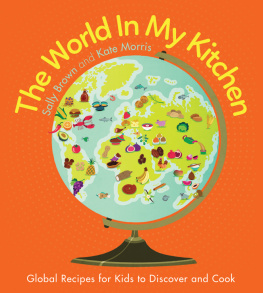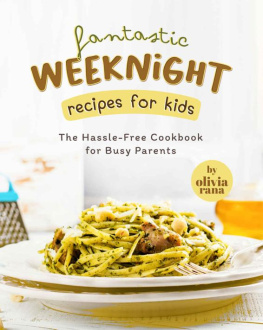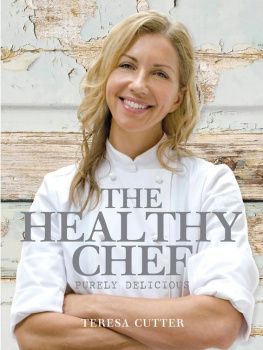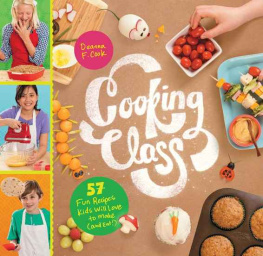 We would like to thank our families for trying out our experiments, and the following for their help in research, testing and photography: Iona and Asher Butterfield, Megan Clarricoates, Megan Cox, Edward Coxhill, Bryn Crampsie, Davina Ellis, Josiah and Austyn Emmanuel, Freya, Louis and Charlie Ham, Bethan and Carys Jones, Mia Barrow, Charlie Lovell, Olivia and James Martin, Anneli Pope, Serena Ha?ner, Elliot Tripp, Olive and Belle Walters, Andrew Ward, and Cathy and Alex in Canada. We would also like to thank Liz Beynon, Colin Campsie and Deirdre Taylor. Washing Hands poem by Lily Morris (aged 9, 2003) Cooking equipment kindly supplied by Lakeland.co.uk To the Young Chef Hold on tight as you are off on an amazing, whistle-stop tour of the globe and you dont even have to leave home, as the flavours, colours and smells will come to you. Many may be familiar but well be putting them together in new and exciting combinations. Its going to be such fun. Every day, children sit down to their meals just like you. But they dont all eat the same things.
We would like to thank our families for trying out our experiments, and the following for their help in research, testing and photography: Iona and Asher Butterfield, Megan Clarricoates, Megan Cox, Edward Coxhill, Bryn Crampsie, Davina Ellis, Josiah and Austyn Emmanuel, Freya, Louis and Charlie Ham, Bethan and Carys Jones, Mia Barrow, Charlie Lovell, Olivia and James Martin, Anneli Pope, Serena Ha?ner, Elliot Tripp, Olive and Belle Walters, Andrew Ward, and Cathy and Alex in Canada. We would also like to thank Liz Beynon, Colin Campsie and Deirdre Taylor. Washing Hands poem by Lily Morris (aged 9, 2003) Cooking equipment kindly supplied by Lakeland.co.uk To the Young Chef Hold on tight as you are off on an amazing, whistle-stop tour of the globe and you dont even have to leave home, as the flavours, colours and smells will come to you. Many may be familiar but well be putting them together in new and exciting combinations. Its going to be such fun. Every day, children sit down to their meals just like you. But they dont all eat the same things.
With these special recipes, you have the chance to make and taste some of the wonderful foods other children eat with their families, when they are out and about, and at special celebrations. Children have tried out all these recipes for us and lots more so we know youll be able to follow and enjoy them. Whatever you are eating, wherever in the world you are, food needs to grow or be reared and lots of people eat mainly what grows near where they live. The plants we grow for food need sunshine, soil and water, but different plants like growing in different temperatures and conditions. So a plant that grows in the hottest parts of the world near the middle, called the Equator, can grow very quickly. But on the top of huge mountains or in the Arctic and the Antarctic, it is so cold that very little can grow.
Do you know what kinds of food plants grow where you live? It is very important that the food we eat contains all the goodness we need to stay healthy. All these recipes dont just taste great, they are good for you, too. Even if you think you cant cook, you should be able to follow the recipes. And the first thing chefs do before they start cooking, is read the whole recipe, then collect all the things they need food and pots and pans. Sous chef Since you are a young chef, you may need a little help, perhaps to find equipment or prepare some ingredients, but mostly just to put your delicious dishes in and take them out of the hot oven. Look for the oven-glove icon  that means you may need a bit of help.
that means you may need a bit of help.
A chefs helper is called a sous chef, so thats what you can call your adult helper. It means they are not as important as the chef! The more often you practise your cooking skills, the less you are likely to need their help. To the Adult Sous Chef All our recipes have been created especially for your child to cook as independently as possible and they have all been tested and tasted by children so we know they work. Let your child do as much as possible on their own, depending on their age and ability. The dishes are based on authentic recipes that we have adapted for children to cook with minimal supervision. We may have reduced the number of ingredients, substituted easy-to-find options or used frozen or canned fruit and vegetables. We have tried to use the same ingredients a number of times so you wont have leftovers in the larder for long.
If your child is not used to some of the spices, try the recipe as printed the first time, then adjust the spice next time. Or add a squirt of lemon juice, as the acid will temper the heat. Cooking on the hob/stovetop or over an open fire is usual in many places around the world but, for safety, we have adapted most recipes to cook in an oven. We devised the recipes with healthy eating in mind so most are high in nutrients and low in sugar, salt and fat. Within that healthy balanced diet, you can enjoy a few of our sweet treats. Most of the recipes are designed to serve two adults and two children.
Others can be stored or are for sharing. Youll find this information at the top of the recipe with the preparation and cooking times and oven temperature. Cooking times are based on a preheated fan oven. Read each recipe through with the child before they start and explain any new techniques (see pages ). Turn on the oven, if necessary, then stand back and let them cook, being there when necessary to get food in and out of the oven, open cans, melt butter or, occasionally, help them use a sharp knife or grater. The oven-glove icon  at the start of a step suggests when the child might need to ask for help.
at the start of a step suggests when the child might need to ask for help.
The recipes were tested in a preheated electric fan oven at the C temperature listed. Every oven can be different, so adjust temperatures as required and check that the dishes are cooked before serving, especially those containing meat and fish. Food should be piping hot when it comes out of the oven so let it cool a little before your young chef has a try. The World In My Kitchen Have you ever wondered what children in other countries eat? What do they have for breakfast? What does their dinner smell like? How does it taste? Do they sit at the table? Why not recreate some of the colourful, exciting and fun ways children eat around the world? Some children may sit on the floor, others at a table. Some might buy their breakfast from a hot-food stall in the street outside their home and then munch it on the way to school. Some dont speak while eating, and you might have to eat in silence in many parts of Africa that could be a bit difficult.
And in some other countries, like Venezuela, you are expected to be very chatty! Why dont you pick some recipes from one of the 14 countries and find out what people wear every day there are their clothes the same as yours or different? Can you dress the same way? You might turn the heating up to make your house extra warm if you are eating Thai, or open all the windows for chilly Finland! What does the table look like when they serve the dishes? In China, people eat with chopsticks instead of knives and forks, and sit on large cushions on the floor can you? People might use both hands to eat, or a knife and fork. The Moroccans use their right hand and serve themselves from big shared dishes in the middle of the table. Think about the country the dishes you are cooking come from. What kind of serving and eating dishes do they use? Ask an adult to help you look on the internet for information about the country you have chosen. You could also look for local music to play while you are eating. Wherever you are in the world, you are sure to find that food is an important part of any celebration.
Children just like you love the excitement of having a party. There are even parties about food! In Italy theres an orange festival in a town called Ivrea can you find it on a map? They throw oranges at each other! The crowds throw tomatoes at La Tomatina festival in Buol, Spain, and in Delhi, India, theres a mango festival where they have mango-eating and mango-carving competitions, quizzes, and tastings of over 1,100 types of mango. In Russia there is a pancake week, called Maslenitsa, just before Easter, when they celebrate the end of winter and the beginning of spring by eating pancakes lots of them! They all sound great fun. What You Need You dont need lots of fancy equipment because we want you to get cooking straight away. Youll find most things in your kitchen, and well list them on the next few pages. If you need anything else, the recipe will tell you.
Next page









 We would like to thank our families for trying out our experiments, and the following for their help in research, testing and photography: Iona and Asher Butterfield, Megan Clarricoates, Megan Cox, Edward Coxhill, Bryn Crampsie, Davina Ellis, Josiah and Austyn Emmanuel, Freya, Louis and Charlie Ham, Bethan and Carys Jones, Mia Barrow, Charlie Lovell, Olivia and James Martin, Anneli Pope, Serena Ha?ner, Elliot Tripp, Olive and Belle Walters, Andrew Ward, and Cathy and Alex in Canada. We would also like to thank Liz Beynon, Colin Campsie and Deirdre Taylor. Washing Hands poem by Lily Morris (aged 9, 2003) Cooking equipment kindly supplied by Lakeland.co.uk To the Young Chef Hold on tight as you are off on an amazing, whistle-stop tour of the globe and you dont even have to leave home, as the flavours, colours and smells will come to you. Many may be familiar but well be putting them together in new and exciting combinations. Its going to be such fun. Every day, children sit down to their meals just like you. But they dont all eat the same things.
We would like to thank our families for trying out our experiments, and the following for their help in research, testing and photography: Iona and Asher Butterfield, Megan Clarricoates, Megan Cox, Edward Coxhill, Bryn Crampsie, Davina Ellis, Josiah and Austyn Emmanuel, Freya, Louis and Charlie Ham, Bethan and Carys Jones, Mia Barrow, Charlie Lovell, Olivia and James Martin, Anneli Pope, Serena Ha?ner, Elliot Tripp, Olive and Belle Walters, Andrew Ward, and Cathy and Alex in Canada. We would also like to thank Liz Beynon, Colin Campsie and Deirdre Taylor. Washing Hands poem by Lily Morris (aged 9, 2003) Cooking equipment kindly supplied by Lakeland.co.uk To the Young Chef Hold on tight as you are off on an amazing, whistle-stop tour of the globe and you dont even have to leave home, as the flavours, colours and smells will come to you. Many may be familiar but well be putting them together in new and exciting combinations. Its going to be such fun. Every day, children sit down to their meals just like you. But they dont all eat the same things. that means you may need a bit of help.
that means you may need a bit of help.